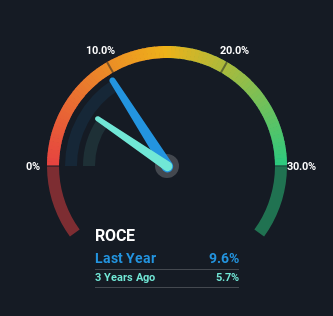Canada Goose Holdings (TSE:GOOS) May Have Issues Allocating Its Capital
Did you know there are some financial metrics that can provide clues of a potential multi-bagger? Ideally, a business will show two trends; firstly a growing return on capital employed (ROCE) and secondly, an increasing amount of capital employed. If you see this, it typically means it's a company with a great business model and plenty of profitable reinvestment opportunities. Having said that, from a first glance at Canada Goose Holdings (TSE:GOOS) we aren't jumping out of our chairs at how returns are trending, but let's have a deeper look.
Return On Capital Employed (ROCE): What Is It?
For those that aren't sure what ROCE is, it measures the amount of pre-tax profits a company can generate from the capital employed in its business. The formula for this calculation on Canada Goose Holdings is:
Return on Capital Employed = Earnings Before Interest and Tax (EBIT) ÷ (Total Assets - Current Liabilities)
0.096 = CA$110m ÷ (CA$1.6b - CA$453m) (Based on the trailing twelve months to December 2023).
Thus, Canada Goose Holdings has an ROCE of 9.6%. In absolute terms, that's a low return but it's around the Luxury industry average of 12%.
Check out our latest analysis for Canada Goose Holdings
In the above chart we have measured Canada Goose Holdings' prior ROCE against its prior performance, but the future is arguably more important. If you'd like, you can check out the forecasts from the analysts covering Canada Goose Holdings here for free.
The Trend Of ROCE
In terms of Canada Goose Holdings' historical ROCE movements, the trend isn't fantastic. Around five years ago the returns on capital were 35%, but since then they've fallen to 9.6%. Although, given both revenue and the amount of assets employed in the business have increased, it could suggest the company is investing in growth, and the extra capital has led to a short-term reduction in ROCE. If these investments prove successful, this can bode very well for long term stock performance.
Our Take On Canada Goose Holdings' ROCE
Even though returns on capital have fallen in the short term, we find it promising that revenue and capital employed have both increased for Canada Goose Holdings. Despite these promising trends, the stock has collapsed 76% over the last five years, so there could be other factors hurting the company's prospects. Therefore, we'd suggest researching the stock further to uncover more about the business.
One more thing: We've identified 2 warning signs with Canada Goose Holdings (at least 1 which makes us a bit uncomfortable) , and understanding these would certainly be useful.
For those who like to invest in solid companies, check out this free list of companies with solid balance sheets and high returns on equity.
Have feedback on this article? Concerned about the content? Get in touch with us directly. Alternatively, email editorial-team (at) simplywallst.com.
This article by Simply Wall St is general in nature. We provide commentary based on historical data and analyst forecasts only using an unbiased methodology and our articles are not intended to be financial advice. It does not constitute a recommendation to buy or sell any stock, and does not take account of your objectives, or your financial situation. We aim to bring you long-term focused analysis driven by fundamental data. Note that our analysis may not factor in the latest price-sensitive company announcements or qualitative material. Simply Wall St has no position in any stocks mentioned.

